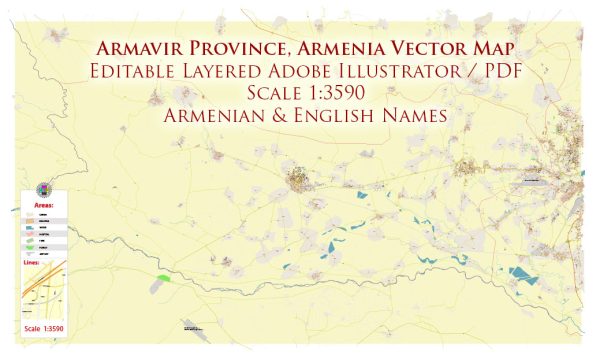Armavir, Armenia, a general overview of Armenia’s political and economic history, and you can then explore more specific information on Armavir.
Vectormap.Net provide you with the most accurate and up-to-date vector maps in Adobe Illustrator, PDF and other formats, designed for editing and printing. Please read the vector map descriptions carefully.
Political History of Armenia:
- Ancient History: The region of present-day Armenia has a rich history dating back to ancient times. It was part of various empires, including the Persian Empire and the Roman Empire.
- Christianity: Armenia became the first nation to adopt Christianity as its state religion in the early 4th century. This had a profound impact on its culture and identity.
- Medieval Period: Armenia experienced various invasions and occupations during the medieval period, including by the Byzantine Empire, Seljuk Turks, and Mongols.
- Ottoman Empire and Persian Rule: In the following centuries, Armenia became part of the Ottoman Empire and later the Persian Empire, enduring periods of cultural and territorial challenges.
- Russian Influence: In the 19th century, Russia and the Ottoman Empire competed for influence in the region. After the Russo-Turkish War (1828-1829), Eastern Armenia, including present-day Armavir, came under Russian control.
- Soviet Era: Armenia became part of the Soviet Union in 1920. During this period, significant industrialization and urbanization took place. Armavir was established as a province during the Soviet era.
- Independence: The collapse of the Soviet Union in 1991 led to Armenia declaring its independence. The country faced challenges related to the Nagorno-Karabakh conflict, economic instability, and political changes.
- Contemporary Politics: Post-independence, Armenia has navigated a complex political landscape. It has experienced periods of economic growth and challenges, with various political developments shaping its trajectory.
Economic History of Armenia:
- Soviet Era: During the Soviet era, Armenia’s economy was integrated into the larger Soviet economic structure. Industrialization and collectivization occurred, but the economy faced challenges as it transitioned to independence.
- Transition Period: The early years of independence in the 1990s were marked by economic difficulties, including hyperinflation and a decline in industrial production.
- Post-2000 Economic Growth: In the 21st century, Armenia experienced periods of economic growth, driven by sectors such as information technology, agriculture, and tourism.
- Challenges: Armenia faced challenges such as the global economic downturn, regional geopolitical tensions, and the Nagorno-Karabakh conflict, impacting its economic stability.
- Reforms and Development: The government implemented economic reforms to attract foreign investment and improve the business environment. The technology sector, in particular, saw significant growth.
To obtain specific information on the political and economic history of Armavir, Armenia, you may need to refer to local historical records, academic studies, or government sources specific to the region. Local archives, historical societies, and government publications can be valuable resources for more detailed and region-specific information.


 Author: Kirill Shrayber, Ph.D.
Author: Kirill Shrayber, Ph.D.